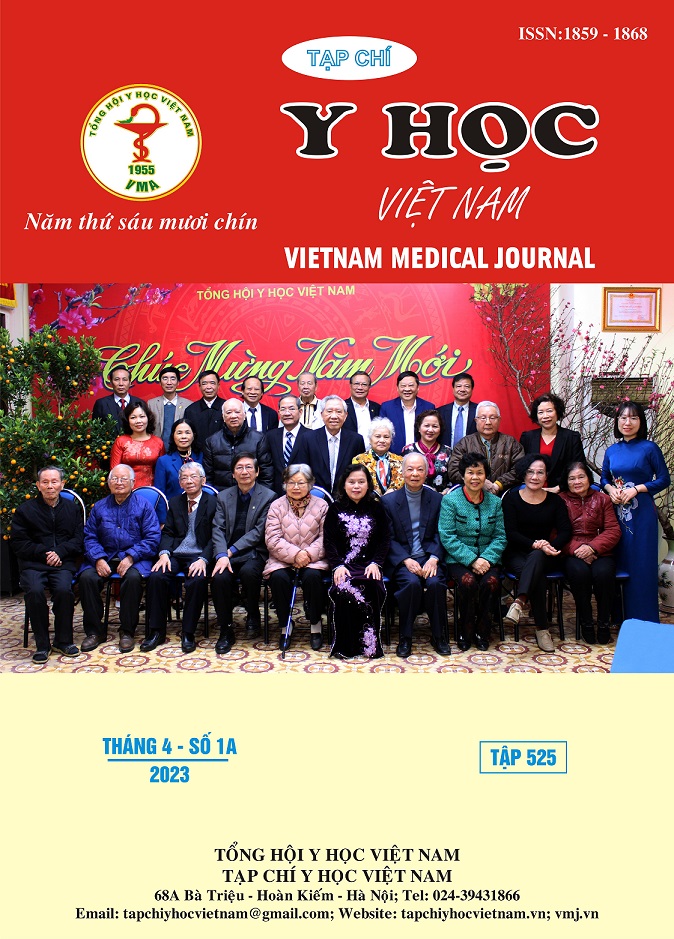TECHNICAL CHARACTERISTICS AND RESULTS OF HEPATIC VENOUS OUTFLOW RECONSTRUCTION IN LIVING DONOR LIVER TRANSPLANTATION USING RIGHT LOBE GRAFT
Main Article Content
Abstract
Objective: To evaluate the technical characteristics and results of hepatic venous outflow reconstruction in right lobe graft living donor liver transplantation. Subject and method: The prospective study was performed on 52 cases of living donor liver transplantation using right lobe graft at 108 Military Central Hospital from January 2019 to December 2020. Results: There were 42 cases of using the extended lobe living donor liver transplant including the middle hepatic vein (80.7%) and 10 cases of the modified right lobe graft with the middle hepatic vein reconstructed from the V5 and/ or V8 branches (19.3%) by using polytetrafluoroethylene artificial vessels. We conjoined the MHV and RHV as a single orifice hepatic vein. The hepatic veins were enlarged to the left and downwards at the orifice of the recipient's right hepatic vein, with a mean incision length of 14 mm and 9.7 mm, respectively. A total of 15/52 accessory right inferior hepatic veins with diameter > 5 mm were anastomosed directly to inferior vena cava (IVC) in an end-to-side fashion in recipient (28.8%). There were 3 cases of middle hepatic vein obstruction (2 stenoses, 1 occlusion) (5.7%). The mortality rate of hepatic venous outflow obstruction was 1,9%. Conclusion: The single orifice hepatic vein reconstruction in LDLT using a right lobe graft is a simple and feasible surgical technique, and it does not require cadaveric vessels. Most of all, it can prevent effectively HV stenosis.
Article Details
Keywords
living donor liver transplantation, hepatic venous outflow reconstruction
References
2. Li PC, Thorat A, Jeng LB,Yang HR (2017). “Hepatic artery reconstruction in living donor liver transplantation using surgical loupes: Achieving low rate of hepatic arterial thrombosis in 741 consecutive recipients-tips and tricks to overcome the poor hepatic arterial flow”. Liver Transpl, 23(7): 887-898.
3. Lee SG (2006). “Techniques of reconstruction of hepatic veins in living-donor liver transplantation, especially for right hepatic vein and major short hepatic veins of right-lobe graft”. J Hepatobiliary Pancreat Surg, 13: 131–138.
4. Kim JD, Choi DL,Han YS (2014). “Simplified one-orifice venoplasty for middle hepatic vein reconstruction in adult living donor liver transplantation using right lobe grafts”. Clin Transplant 28: 561–8.
5. Lee TB, Ryu JH,Chu CW (2018). “Diamond-shaped patch technique for right hepatic vein reconstruction in living-donor liver transplant: A simple method to prevent stenosis”. Medicine, 97(34): e11815.
6. Koc S, Akbulut S, Soyer V (2017). “Hepatic venous outflow obstruction after living-donor liver transplant: single center experience”. Experimental and clinical transplantation, 19(8): 1-11.
7. Kim KS, Lee JS,Cho GS (2018). “Long-term outcomes after stent insertion in patients with early and late hepatic vein outflow obstruction after living donor liver transplantation”. Ann Surg Treat Res, 95(6): 333-339.
8. Sugawara Y, Makuuchi M,Akamatsu N (2004). “Refinement of venous reconstruction using cryopreserved veins in right liver grafts”. Liver Transplantation, 10(4): 541–547.
9. Hwang S, Lee SG,Ahn CS (2005). “Cryopreserved iliac artery is indispensable interposition graft material for middle hepatic vein reconstruction of right liver grafts”. Liver Transplantation, 11(6).


